Top News
August 21, 2020 Ryukyu Shimpo
During a mass outbreak of the novel coronavirus occurred on the U.S. Navy’s USS Theodore Roosevelt en route, the U.S. military considered a plan to transport about 3,000 crewmembers to U.S. military bases in Okinawa. The crew eventually disembarked in Guam, but they have been withdrawn, so there has been no talk of remedying the situation.
By this stage, bringing a large group of people, including people who test positive for the coronavirus, to other countries’ territories should be considered an absolutely unacceptable option. Clearly the U.S. military’s perception is that it can freely use Okinawa as if it was U.S. territory. The continuation of such circumstances is due to nothing other than the weak attitude of the Japanese central government, which has come to accept the U.S. military’s stance.
The Japanese government must correct the U.S. military’s designs in terms of the planned transport of these crewmembers to Okinawa. It is essential that we strongly protect so that coronavirus infection is not brought in by way of the U.S. military.
According to an investigative report from the U.S. Navy, three crewmembers were confirmed to have the novel coronavirus on March 24, when the USS Roosevelt was en route from Vietnam to Guam in the western Pacific Ocean. In considering an isolation location for the crewmembers, the 7th Fleet Headquarters calculated that a total of 3,000 rooms could be secured on Marine Corps military bases in Okinawa, such as Futenma Air Station, and initially planned to transport crewmembers from the aircraft carrier to Okinawa by air route.
There was a possibility that the crewmembers would be transported from the USS Roosevelt to Okinawa and settle in prior to acceptance from the Japanese government.
Under Article 9 of the U.S.-Japan Status of Forces Agreement, U.S. military personnel are allowed special privileges relating to emigration and immigration, and U.S. military troops may directly enter military bases across Japan by U.S. military aircraft, exempt from Japan’s medical inspections.
In whatever manner Okinawa and Japan attempt to prevent the coronavirus being brought in over national boarders, the presence of the U.S. military bases is an unfortunate hole in the countermeasures. Initially, the U.S. military made no public announcement about the numbers of people infected within Okinawa. Also, circumstances, such as the infection status on military bases due to U.S. troops entering Japan and the medical care set-up, have been kept entirely in a black box.
In the mass outbreak, out of the total of about 4,800 crewmembers on the USS Roosevelt, 1,248 people or one in four people were infected, and one person died.
If 3,000 U.S. troops from among this crew disembark in Okinawa, there is a high possibility that the infection will spread off-base, and that Okinawan society will face severe conditions. From observing the current infection status in Okinawa, it is easy to presume that one factor was the spread of infection on the U.S. military bases.
From reading the U.S. Navy report, it can be understood that Okinawa is being used as a location for receiving infected persons in the U.S. military. When the plan for transporting these crewmembers was being formulated, there was no prior consultation or discussion of medical inspections with the Japanese government or the Okinawa Prefectural Government. Extraterritorial conduct is being permitted.
Now there is fear that infected persons have quietly been brought to places other than U.S. military bases on Okinawa. It is essential that we firmly handle this situation in order to not permit a second plan for such transport to Okinawa.
(English translation by T&CT and Erin Jones)
Go to Japanese

August 20, 2020 Ryukyu Shimpo
Ishigaki – The Ishigaki citizens’ liaison committee to prevent military base construction on Ishigaki Island sent a written demand to the Ministry of Defense and the Okinawa Defense Bureau August 17, demanding that construction cease on a Japan Ground Self Defense Force (JGSDF) garrison in the neighborhood of Hirae-Omata. The group is protesting that the excavation and rock-demolishing taking place on a former golf course that is part of the planned garrison site is causing noise pollution, damaging everyday life and the surrounding environment.
In the written demand, the community group expressed concern over the garrison “becoming a target,” and the effect the facilities would have on the surrounding waterways and ecosystem. Additionally, they argued that since there was not a local referendum vote on the deployment, the consent of Ishigaki’s residents had not been established. They also expressed their concern over construction workers entering and leaving the island while COVID-19 continues to spread.
With consideration to the Aegis Ashore deployments in Akita and Yamaguchi prefectures, which were scrapped due to concerns over the missiles’ booster stages, the letter indicated, “The surface-to-ship missiles’ boosters [to be deployed at the garrison] would fall over an area where defenseless citizens are living. The missile defense base, which is intended to protect the citizens’ lives, is instead threatening it.”
On August 17, a press conference was held at Ishigaki City Hall, and liaison committee joint representative Tetsuhiro Kinjo pleaded, “The Aegis Ashore initiative was cancelled after heavy local opposition. In Okinawa [construction] unilaterally continues, whether it be in Henoko or in Ishigaki. Since we are citizens just the same, the Ministry of Defense should heed out words seriously, and call of construction.”
Since there is a possibility that construction will also proceed for the portion of the garrison on what was formerly city property, the liaison committee again called for construction to be stopped.
(English translation by T&CT and Sam Grieb)
Go to Japanese

August 15, 2020 Ryukyu Shimpo
By Megumi Kiyomura
(Tarama) On July 25, around 30 green sea turtles hatched on the beach on the northern side of Tarama Village, Okinawa. The turtles were discovered by 7th grader Kazuki Kiyomura, age 13, of Tarama. The turtles determinedly making their way from the beach to the sea swam off into the great wide ocean one by one, helped along by the waves.
According to Takahide Sasai of the Okinawa Churaumi Foundation Research Center’s animal research room, the turtles are green sea turtles, which live in coastal areas in tropical and subtropical regions around the world. They are designated as endangered on the Red List of the International Union for Conservation of Nature (IUCN).
More green sea turtles have been sighted on the coast of Tarama Village this year than last year. “The number of green sea turtle eggs laid and number of green sea turtles around the Yaeyama Islands and Okinawa Island are trending upward. There is likely a good chance that green sea turtles in the sea around Tarama Island are increasing as well,” said Sasai.
“I want people to be proud that we have excellent beaches where green sea turtles come to lay eggs. Green sea turtles sometimes feed in shallow waters where they can be seen by snorkelers,” said Sasai, and urged people, “if you see them, please watch over them kindly and do not touch them.”
(English translation by T&CT and Sandi Aritza)
Go to Japanese

August 17, 2020 Ryukyu Shimpo
By Chie Tome
Yomitan – “I wonder what fun things today will bring?” The smiling face saying this is none other than 100-year old Fumi Toyama, who lives by herself in Senaha, Yomitan. While she moves slowly about the house with the help of a cane, her mind still runs at full speed. “I suppose conversation is the key to a long life.” At 100, her surprisingly vigorous voice reverberates through her parlor.
Fumi was born in 1920, the oldest of eight siblings. From a young age, she was pressed to help out around the house, “I don’t have memories of playing. The reason my legs are sturdy even now is thanks to my strict mother.” She says she only went to school for the six years of elementary school.
Fumi married at age 20, however her husband was conscripted into the military for the Battle of Okinawa, and was killed a few days after the birth of her oldest daughter. Working jobs such as selling insurance and collecting electrical bill fees, she was able to make a living and raise three children by herself. “In any case, we never had much money, and there was a lot of hardship.” She also at times had to borrow money for her children’s schooling and to invest in their future. However, in order to ensure her children had all the opportunities available to them, she grit her teeth and pressed forward.
By the time her kids were grown she was in her 40’s, and started focusing her attention on election activities such as serving as the chairwoman of the Liberal Democratic Party’s (LDP) Chubu regional women’s association. She has maintained her belief that, “Politics have a direct link to everyday life, so you must think very hard and vote,” and she boasted that she has voted in every election possible, from national elections to ward mayor elections.
In her 50’s she enjoyed travelling abroad, and at 67 she started to learn to play the koto. She pointed to a picture of Osamu Hayashi on her wall, of whom she is a big fan, and said, “There’s no time like the present. If there is something to do, ‘ima deshou’ (do it now!)” with a playful smile.
Living by herself, she asserted, “I do all the housework and cleaning myself for the sake of my body. I have family nearby, so I am fine.” She has been blessed with 10 grandchildren, and 22 great-grandchildren. She enjoys nothing more than when her family gathers at her house every Saturday. They enjoy meals together like curry rice and rafute. Her oldest son Shoken, 80, said, “Since long ago she has had a serious demeanor with a passion for education. All of the hardship she experienced has made her compassionate and kind. I want to keep seeing her healthy, for even one more day.”
“Good fortune will come to those who smile, and smiles are a nutrient for the body.” Fumi said, “I want to make that my ‘motto for life.’”
(English translation by T&CT and Sam Grieb)
Go to Japanese

August 11, 2020 Ryukyu Shimpo
JICA Okinawa (Japan International Cooperation Agency Okinawa Center) recently uploaded a rendition of Shokichi Kina’s hit song “Hana” sung in 14 languages and in the Okinawan language to YouTube. The music video is meant to spread hope to those feeling confined at home due to the novel coronavirus pandemic and was created by 38 active and former JICA members with connections to Okinawa.
In March, the organization returned all of its overseas volunteers to Japan from their respective countries, due to the global spread of COVID-19. Many of its Okinawan members are currently awaiting the next opportunity to work abroad. In the music video uploaded to YouTube, each member sings in the language of the country where they worked.
Okinawa City resident Masaru Tokusato, 29, was the mastermind behind the video. Tokusato volunteered at a school in Senegal last year. He said, “I wanted to spread hope and send the message that we will get through [the pandemic] together. We sang in the languages of the countries we worked in because we wanted to let the local people know that they are in our thoughts.”
Click on the link to check out the music video: https://www.youtube.com/watch?v=Xl8EcxvtGC0
(English translation by T&CT and Monica Shingaki)
Go to Japanese
August 14, 2020 Ryukyu Shimpo
August 13, 2020, marks 16 years from the day a CH-53D heavy-lift transport helicopter departed U.S. Marine Corps Air Station Futenma, crashed at Okinawa International University and burst into flames.
MCAS Futenma’s airfield continues to occupy the city’s urban area. MV-22 Ospreys with vertical take-off and landing capabilities, as well as old aircrafts, come and go as they please. Who can guarantee that a local resident will not get caught up in another accident?
Both the Japanese and U.S. governments agreed on building a new military base in Henoko as a pre-condition to close and return the Futenma base to Okinawa. However, constructing a new base at Henoko has delayed the elimination of the dangers posed by MCAS Futenma for nearby residents. The government should be engaging in discussions of closing the Futenma base unconditionally and expeditiously, as well as its relocation to a site outside the prefecture.
Even after the helicopter incident at OIU, the U.S. military went ahead and deployed Ospreys to MCAS Futenma in 2012, doubling down on the base’s functions. It was four years later in 2016, that an Osprey crashed off the coast of Abu, Nago City. At that moment, the local residents’ fears became reality.
Later, in December 2017, a component of an aircraft detached mid-flight and landed on Midorigaoka Kindergarten School in Nodake, Ginowan City. Elsewhere, at the Futenma Daini Elementary School, a window fell off of a CH-53E helicopter and landed on the school’s sports field.
Originally, the U.S. and Japan agreed on closing MCAS Futenma and returning the land to Okinawa, in an April 1996 pact. Then-governor Hirokazu Nakaima called for the Futenma base to be “closed within five years,” and Prime Minister Shinzo Abe backed the request in 2013. However, promises were broken as this 5-year plan expired in February 2019.
Seeing how the Japanese government is still fixated on Henoko, even with its construction delays due to the ground improvement work required to correct the soft seabed at Oura Bay, it is hard to believe they are in a serious rush to close MCAS Futenma.
It is entirely possible to close Futenma base without relocating it to Henoko if the Marines stationed in Okinawa are diverted elsewhere.
Amphibious assault ships, which are a means of transportation for the Marines, are based in Sasebo, Nagasaki Prefecture, far away from Okinawa. There is no operational need for the Marines in Japan to be stationed in Okinawa specifically. In fact, the U.S. military strategically moved some of its forces concentrated in Okinawa to other areas in the Asia Pacific region, such as Australia and Guam in response to China’s missile capabilities.
If the Japanese government is serious about closing MCAS Futenma, it should be examining new realistic solutions instead of upholding a plan devised more than 20 years ago, which involves relocating the base within Okinawa. The fact that the Henoko project is in effect entrenching the Futenma base where it stands, is nothing more than political inaction.
When the helicopter crashed at OIU 16 years ago, American soldiers encircled the scene and blocked off Japanese investigation authorities. It clearly demonstrated that the authority of the U.S. military takes precedence over Japan’s sovereignty and the university’s autonomy, and illustrated how Japan is politically subservient to the U.S.
The incident was a wake-up call for us to realize the abnormality of having a military base located in a place where civilians live their daily lives. It has been 16 years since the crash, and it is paramount that we discuss the incident time and again, to relay those lessons to the young generation.
(English translation by T&CT and Monica Shingaki)
Go to Japanese

August 13, 2020 Ryukyu Shimpo
Around 6:00 p.m. on August 12, it was confirmed that four large helicopters belonging to the Metropolitan Police Department, the Osaka Prefectural Police, and the like are parked at Naha Airport. According to Okinawa Prefectural Police personnel, these helicopters were dispatched in preparation for the closing of the fishing season for Chinese fishing boats in the East China Sea on August 16, and are poised for guard activities near the Senkaku Islands.
In June this year the Ishigaki City Assembly adopted a bill for changing “Tonoshiro” (on Ishigaki Island) to “Tonoshiro Senkaku” using the characters used for the Senkaku Islands, therby emphasizing opposition to China’s position on sovereignty of the islands. Concerned persons mentioned that 100-200 fishing boats from Zhejiang Province and the like entered Japan’s exclusive economic zone and territorial waters, and these persons also reported that the boats were being used for fishing activities.
According to Okinawa Prefectural Police personnel the large helicopters from other prefectural police departments have been dispatched to Naha Airport for several years, and are collectively used during the closed fishing season for Chinese fishing boats.
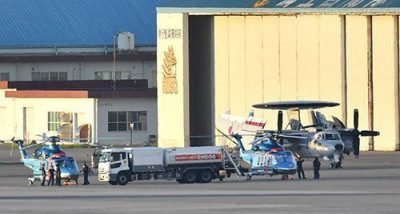
Helicopters belonging to police departments from other prefectures poised for guarding the Senkaku Islands on August 12 at Naha Airport (photograph by Moriaki Kise)
(English translation by T&CT and Erin Jones)
Go to Japanese
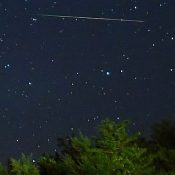
August 13, 2020 Ryukyu Shimpo
Mention of the Perseid Meteor Shower conjures up images of the night sky in summer. The meteor shower was at its peak from late night on August 12 until just before dawn on August 13. The meteors leaving trails as they streaked across the night sky were even seen in every region of Okinawa.
In the mountains of Higashi Village, where the sky is unpolluted by light from town, the sky was fortunately clear. Meteors could be seen racing past the Milky Way, forming fuzzy, white belts across the sky. From approximately 10 p.m. on August 12 until 1 a.m. on August 13, dozens of meteors could be seen with the naked eye.
Tamaki Nakajima, a photographer based in Naha, photographed the meteors running north to south, as though tunneling through the center of the Milky Way, at 10:30 p.m. on August 12 from his spot on Gushichan Beach in Yaese Town.
Nakajima says, “I was taking photos with two cameras at the same time. When I got this shot of the meteors, I couldn’t contain my awe.”
The Perseid Meteor Shower should be clearest in the night sky until just before dawn on August 14.

Meteors from the Perseid Meteor Shower cross the sky near the Milky Way (Left) (11:20 p.m., August 12, Kesashi, Higashi Village. Photo by John Matsumoto)
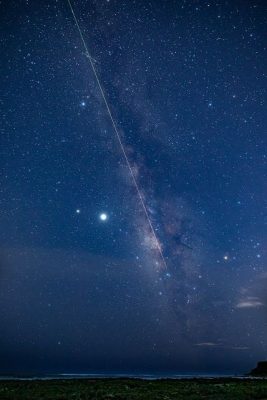
Meteors from the Perseid Meteor Shower appearing to tunnel through the Milky Way (Photo by Tamaki Nakajima) (10:30 p.m., August 12, Gushichan Beach, Yaese Town)
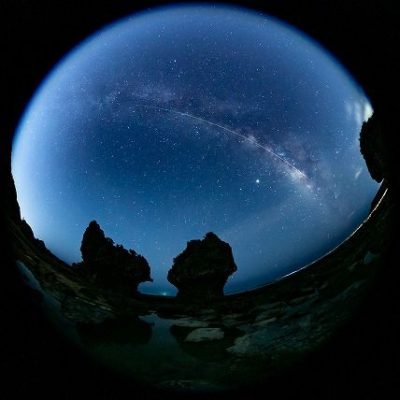
The Milky Way and meteors, photographed with a fisheye lens (Photo by Tamaki Nakajima) (10:30 p.m., August 12, Gushichan Beach, Yaese Town)
(English translation by T&CT and Ellen Huntley)
Go to Japanese

August 13, 2020 Ryukyu Shimpo Digital Edition
Okinawa Prefecture announced August 13 that they were raising their COVID-19 alert level to the highest of their 4 levels, “rampant spread,” and have extended Okinawa’s state of emergency, originally scheduled to expire August 15, through August 29. However, as Okinawa enters its busiest part of the year for tourism, they have not enacted restrictions on travel from outside the prefecture.
Of the seven indicators that determine the alert level in Okinawa, with the exception of “percentage of hospitalizations for seriously ill patients,” and “percentage of patients whose conditions have worsened within a week of hospitalization,” five of the indicators have reach the status of alert level 4.
In previous examples of the alert level in Okinawa being raised to level 4, Okinawan residents were asked to stay at home, and travel restrictions from outside the prefecture were put in place. Since the Okinawan economy is centered mostly around tourism, there were some who raised their voice in opposition to strict travel restrictions as part of the increase in alert level.
(English translation by T&CT and Sam Grieb)
Go to Japanese
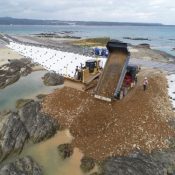
August 8, 2020 Ryukyu Shimpo
Ryukyu Shimpo utilizes drones to report on U.S. military base issues in Okinawa, such as functional enhancements made to the bases, and the extents of any damages caused by the military. Specifically, drones flying over the waters near Camp Schwab in Henoko, Nago City, can capture the ongoing construction at the planned site of the new base up close. This has helped the paper report on the project’s progress and any of its illegalities. Drones have also been used to capture footage of the aftermath of a mountain fire that occurred at Camp Hansen, which helped report on the impacts of the military’s activities.
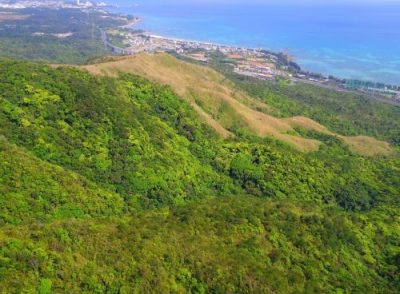
Mount Onna covered in budding green leaves. Parts of the earth are exposed to view, where the military’s live-fire exercises caused a fire; only shrubs and grass have grown back. (Footage captured with a drone on Mar 20, 2017.)
A drone also helped document the scene when land reclamation work began at Henoko Bay on December 14, 2018, as part of the new base construction. The very next day, the front page of Ryukyu Shimpo’s print edition, dated December 15, 2018, featured a photo of a dump truck unloading soil and sand into the ocean. The recent restriction on drones may thwart the paper’s future efforts to capture such in-depth photos of the construction project.
A drone used in “Uruma Kikō—A Bird’s Eye View,” a project to capture the scenery around Okinawa, took aerial shots of Mount Onna—the training facility attached to Camp Hansen. The footage showed bare patches of land with red surface soils, revealing the environmental impacts of the live-fire exercises conducted by the U.S. military.
On the other hand, drones cannot fly over U.S. MCAS Futenma or Kadena Air Base, due to the manufacturers’ self-imposed restrictions.
Drones have helped reporting on the Northern Training Area helipad construction, as well as the Ie-Jima Auxiliary Airfield landing strip expansion. Although these areas were not included in the latest drone use restrictions, the Ministry of Defense has indicated it will expand its scope in the future. Reporting on events happening in these locations are likely to be impacted in the times ahead.
(English translation by T&CT and Monica Shingaki)
Go to Japanese

August 10, 2020 Ryukyu Shimpo
By Special Correspondent Hideaki Yoneda
Tokashiki – With summer reaching its peak, the harlequin glorybower (part of the Lamiaceae family) can be seen full bloom. The flower grows from the island lowlands to up in the mountains, and are often seen lining the streets and hiking trails, pleasing the eyes of the people who pass through with their sweet, white flowers.
The large deciduous shrub can be found anywhere from southern Kyushu and throughout Okinawa, growing anywhere from 2-5 meters, and is sometimes referred to as kusabagi (smelly leaf tree) in Okinawa. In summer, the base of the leaves and ends of branches bloom many small, white, fragrant flowers that look like propellers in a cyme flower cluster, and the leaves grow in a triangular oval. The leaves can be eaten in tempura dishes or served with fish cooked in miso. The flowers can be seen in bloom until around September.
(English translation by T&CT and Sam Grieb)
Go to Japanese














 Webcam(Kokusai Street)
Webcam(Kokusai Street)


